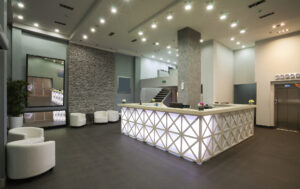Whether it’s working from home or working from the office, lighting plays an important part in everyday work life. While it might not often be thought about, good lighting is essential to getting work done efficiently.
No one wants to work in a dark working environment where they cannot see their work in front of them. On the other hand, no one wants to work in an environment that is too bright either. Office lighting can affect employees both positively and negatively, so it’s important to understand how to get it just right.
What are the benefits of natural lighting?
Having a well-lit workspace does not just have to involve lighting fixtures and bulbs. Natural lighting is healthy to include in every working space to provide employees with some daylight while they are working indoors.
It can help increase productivity
This year, research has shown that UK employee productivity increased through remote working during lockdown. This can be down to a reduction in distractions usually encountered in the office. Natural lighting can also help to increase productivity of workers too as it can help boost moods. Good lighting increases productivity as it gives workers a positive working attitude that leads to a productive mindset at work.
It promotes positive health for workers
Poor office lighting conditions can have a negative effect on workers if it is not corrected. Work environments that are too dark or too bright can lead to eye strain and headaches which in turn can affect an employees productivity and health. Natural lighting used in office spaces of home offices can help relax employees and reduce stress levels.
It helps to protect worker’s safety
One of the most important aspects for any business to prioritise is the safety and welfare of their staff. An office space that is too dark can pose serious safety risks if not corrected. Poor lighting can make trip and slip hazards such as computer wires and spillages harder to see and to avoid. To help prevent unnecessary accidents, natural lighting can help to add more light to a room if lighting fixtures alone are not enough.
Tips on choosing the best lighting options for an office space
Whether it’s sitting at a computer in the office or conducting Zoom presentations at home, it can be beneficial to use the correct lighting to help improve productivity and reduce eye strain. LED lighting is a popular type of lighting that can be used for work environments. LED lights are cheaper, long lasting, and energy-efficient, if you’re wondering how LED lighting helps save money.
Install lights that are best suited for work tasks
Office spaces vary from one office to another depending on the type of task that workers will perform in that zone. Some offices will demand ceiling lighting, which may be over illuminating while others will require layered light that is easy to control. So, choose the lighting option that will allow effectiveness while working. For example, a table lamp might not be useful to use when conducting a business presentation in a meeting room.
Consider using a lighting control system for flexibility
In office spaces or home office environments, dimmer switches can help to adjust the lighting throughout the day. Rather than having one set setting, adjustable lighting can be more flexible to working conditions depending on how light or dark you need the office to be. To help save money, lighting timers and motion sensor lighting might be useful too in areas like office restrooms, where lighting doesn’t need to be left on all day.
Utilise natural lighting if you have access to it
Increased productivity and improved moods are just some natural lighting health benefits that employees can gain at home and in a larger office space. If there is access to window space, then make the most out of it to save on lighting costs and add more daylight to the office environment.
Choose lighting that works best for the whole room
Not all types of lighting is going to work well for the whole office space. For example, desk lamps might be good for individual workers but not enough to light an entire office cubicle area. Instead, lighting fixtures such as LED panel lights can help save on lighting. For a home office space, if there is just one person working, then natural lighting by a window or a simple desk lamp could work well.
